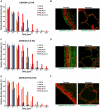Determinants of glycan receptor specificity of H2N2 influenza A virus hemagglutinin
- PMID: 21060797
- PMCID: PMC2966429
- DOI: 10.1371/journal.pone.0013768
Determinants of glycan receptor specificity of H2N2 influenza A virus hemagglutinin
Abstract
The H2N2 subtype of influenza A virus was responsible for the Asian pandemic of 1957-58. However, unlike other subtypes that have caused pandemics such as H1N1 and H3N2, which continue to circulate among humans, H2N2 stopped circulating in the human population in 1968. Strains of H2 subtype still continue to circulate in birds and occasionally pigs and could be reintroduced into the human population through antigenic drift or shift. Such an event is a potential global health concern because of the waning population immunity to H2 hemagglutinin (HA). The first step in such a cross-species transmission and human adaptation of influenza A virus is the ability for its surface glycoprotein HA to bind to glycan receptors expressed in the human upper respiratory epithelia. Recent structural and biochemical studies have focused on understanding the glycan receptor binding specificity of the 1957-58 pandemic H2N2 HA. However, there has been considerable HA sequence divergence in the recent avian-adapted H2 strains from the pandemic H2N2 strain. Using a combination of structural modeling, quantitative glycan binding and human respiratory tissue binding methods, we systematically identify mutations in the HA from a recent avian-adapted H2N2 strain (A/Chicken/PA/2004) that make its quantitative glycan receptor binding affinity (defined using an apparent binding constant) comparable to that of a prototypic pandemic H2N2 (A/Albany/6/58) HA.
Conflict of interest statement
Figures






Similar articles
-
Receptor specificity and transmission of H2N2 subtype viruses isolated from the pandemic of 1957.PLoS One. 2010 Jun 21;5(6):e11158. doi: 10.1371/journal.pone.0011158. PLoS One. 2010. PMID: 20574518 Free PMC article.
-
Dual receptor-binding, infectivity, and transmissibility of an emerging H2N2 low pathogenicity avian influenza virus.Nat Commun. 2024 Nov 19;15(1):10012. doi: 10.1038/s41467-024-54374-z. Nat Commun. 2024. PMID: 39562538 Free PMC article.
-
Influenza Virus Hemagglutinins H2, H5, H6, and H11 Are Not Targets of Pulmonary Surfactant Protein D: N-Glycan Subtypes in Host-Pathogen Interactions.J Virol. 2020 Feb 14;94(5):e01951-19. doi: 10.1128/JVI.01951-19. Print 2020 Feb 14. J Virol. 2020. PMID: 31826991 Free PMC article.
-
H2 influenza viruses: designing vaccines against future H2 pandemics.Biochem Soc Trans. 2019 Feb 28;47(1):251-264. doi: 10.1042/BST20180602. Epub 2019 Jan 15. Biochem Soc Trans. 2019. PMID: 30647144 Review.
-
Receptor binding and pH stability - how influenza A virus hemagglutinin affects host-specific virus infection.Biochim Biophys Acta. 2014 Apr;1838(4):1153-68. doi: 10.1016/j.bbamem.2013.10.004. Epub 2013 Oct 24. Biochim Biophys Acta. 2014. PMID: 24161712 Review.
Cited by
-
Decoding the distribution of glycan receptors for human-adapted influenza A viruses in ferret respiratory tract.PLoS One. 2012;7(2):e27517. doi: 10.1371/journal.pone.0027517. Epub 2012 Feb 16. PLoS One. 2012. PMID: 22359533 Free PMC article.
-
Human monoclonal antibodies to pandemic 1957 H2N2 and pandemic 1968 H3N2 influenza viruses.J Virol. 2012 Jun;86(11):6334-40. doi: 10.1128/JVI.07158-11. Epub 2012 Mar 28. J Virol. 2012. PMID: 22457520 Free PMC article.
-
Two glycosylation sites in H5N1 influenza virus hemagglutinin that affect binding preference by computer-based analysis.PLoS One. 2012;7(6):e38794. doi: 10.1371/journal.pone.0038794. Epub 2012 Jun 14. PLoS One. 2012. PMID: 22719948 Free PMC article.
-
Structural determinants for naturally evolving H5N1 hemagglutinin to switch its receptor specificity.Cell. 2013 Jun 20;153(7):1475-85. doi: 10.1016/j.cell.2013.05.035. Epub 2013 Jun 6. Cell. 2013. PMID: 23746829 Free PMC article.
-
Glycan receptor binding of the influenza A virus H7N9 hemagglutinin.Cell. 2013 Jun 20;153(7):1486-93. doi: 10.1016/j.cell.2013.05.034. Epub 2013 Jun 6. Cell. 2013. PMID: 23746830 Free PMC article.
References
-
- Makarova NV, Kaverin NV, Krauss S, Senne D, Webster RG. Transmission of Eurasian avian H2 influenza virus to shorebirds in North America. J Gen Virol. 1999;80 (Pt 12):3167–3171. - PubMed
-
- Schafer JR, Kawaoka Y, Bean WJ, Suss J, Senne D, et al. Origin of the pandemic 1957 H2 influenza A virus and the persistence of its possible progenitors in the avian reservoir. Virology. 1993;194:781–788. - PubMed
-
- Russell CJ, Webster RG. The genesis of a pandemic influenza virus. Cell. 2005;123:368–371. - PubMed
-
- Tumpey TM, Basler CF, Aguilar PV, Zeng H, Solorzano A, et al. Characterization of the reconstructed 1918 Spanish influenza pandemic virus. Science. 2005;310:77–80. - PubMed
Publication types
MeSH terms
Substances
Grants and funding
LinkOut - more resources
Full Text Sources
Other Literature Sources

